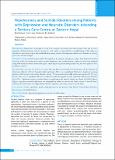Please use this identifier to cite or link to this item:
https://hdl.handle.net/20.500.14356/1684Full metadata record
| DC Field | Value | Language |
|---|---|---|
| dc.contributor.author | Pokharel, Rita | - |
| dc.contributor.author | Lama, Sami | - |
| dc.contributor.author | Adhikari, Baikuntha Raj | - |
| dc.date.accessioned | 2023-05-18T07:54:30Z | - |
| dc.date.available | 2023-05-18T07:54:30Z | - |
| dc.date.issued | 2016 | - |
| dc.identifier.citation | PokharelR., LamaS., & AdhikariB. R. (2017). Hopelessness and Suicidal Ideation among Patients with Depression and Neurotic Disorders Attending a Tertiary Care Centre at Eastern Nepal. Journal of Nepal Health Research Council, 14(3). https://doi.org/10.33314/jnhrc.v14i3.873 | en_US |
| dc.identifier.issn | Print ISSN: 1727-5482; Online ISSN: 1999-6217 | - |
| dc.identifier.uri | http://103.69.126.140:8080/handle/20.500.14356/1684 | - |
| dc.description | Original Article | en_US |
| dc.description.abstract | Abstract Background: Hopelessness is thought to result from a negative appraisal system and interacts with, and worsens, appraisals of defeat and trap which in turn interact with suicide schema and lead to suicidal behaviour. This study was intended to assess hopelessness and suicidal ideation among patients with depression and neurotic disorders at tertiary care centre of eastern Nepal. Methods: A cross sectional design included 70 respondents by purposive sampling technique. Beck Hopelessness Scale and Scale of Suicidal Ideation were used to measure hopelessness and suicidal ideation, respectively. Data were analyzed using SPSS statistical software. Pearson chi-square, binary logistic regression and Spearmans’ rho, test were applied at 95% confidence interval. Results: Mean ± SD age was 32.8 ± 13.5 years. Most (62.8%) of the patients were female and with the diagnosis of depression. Majority (66%) of the patients had hopelessness. There was no significant difference in hopelessness among patients with depression and neurotic disorders. About 17% respondents had suicidal ideation, among them 82.4% were female. There was no significant difference of suicidal ideation among patients with depression and neurotic disorders (p=0.013). Significant positive correlation between hopelessness and suicidal ideation was found (p=0.001). Binary logistic regression revealed hopelessness was independently related to income and family history of mental illness. Similarly, suicidal ideation was independently related to depression and family history of mental illness. Conclusions: Female respondents, people living under poverty and positive family history of mental illness had more hopelessness and suicidal ideation. Keywords: Anxiety; depression; hopelessness; neurotic; suicidal ideation. | en_US |
| dc.language.iso | en | en_US |
| dc.publisher | Nepal Health Research Council | en_US |
| dc.relation.ispartofseries | Sep-Dec, 2016;873 | - |
| dc.subject | Anxiety | en_US |
| dc.subject | Depression | en_US |
| dc.subject | Hopelessness | en_US |
| dc.subject | Neurotic | en_US |
| dc.subject | Suicidal ideation | en_US |
| dc.title | Hopelessness and Suicidal Ideation among Patients with Depression and Neurotic Disorders Attending a Tertiary Care Centre at Eastern Nepal | en_US |
| dc.type | Journal Article | en_US |
| local.journal.category | Original Article | - |
| Appears in Collections: | Vol. 14 No. 3 Issue 34 Sep-Dec 2016 | |
Files in This Item:
| File | Description | Size | Format | |
|---|---|---|---|---|
| 873-Article Text-1648-2-10-20170528.pdf | Fulltext Download | 166.2 kB | Adobe PDF |  View/Open |
Items in DSpace are protected by copyright, with all rights reserved, unless otherwise indicated.
